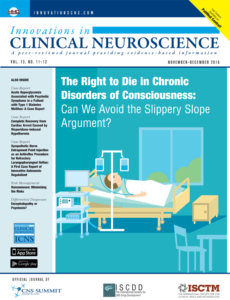 Dear Colleagues:
Dear Colleagues:
Welcome to the November–December 2016 issue of Innovations in Clinical Neuroscience. We begin this issue with a thoughtful review and commentary by Calabró et al titled, “The Right to Die in Chronic Disorders of Consciousness: Can We Avoid the Slippery Slope Argument?” Here the authors review current opinions and ethical issues concerning end-of-life decisions in patients with disorders of consciousness (DOCs) (i.e., vegetative state, minimally conscious state), including the impact misdiagnoses of DOCs may have on end-of-life decisions, the concept of “dignity” and “sanctity” of human life in view of end-of-life decisions, and the risk of the “slippery slope” argument when dealing with euthanasia and end-of-life decisions. The authors share their own ethical perspective on the subject and provide suggestions on how to avoid ambiguity while identifying what is best for the patient with a DOC and his or her family through the establishment of evidence-based criteria and protocol for managing end-of-life decisions among this patient population.
Next, Sahoo et al present a case report titled, “Acute Hyperglycemia Associated with Psychotic Symptoms in a Patient with Type 1 Diabetes Mellitus: A Case Report.” The authors present the case of a woman with Type 1 diabetes mellitus (T1DM) who developed recurrent episodes of psychosis. After considering the patient’s history and observing her response to treatment, the authors concluded that the episodes of psychosis were due to significantly high levels of blood glucose in the patient following poor adherence to her insulin therapy. Much has been published regarding the association of certain psychiatric with hypoglycemia; however, the association of hyperglycemia with psychiatric manifestations has been less commonly reported. Clinicians should consider the authors’ observations of this patient when treating patients with T1DM who present with symptoms of psychosis that cannot be attributed to other pathologies.
Following this, Nagamine presents the case report, “Complete Recovery from Cardiac Arrest Caused by Risperidone-induced Hypothermia.” Here, the author describes a patient with schizophrenia who was taking risperidone and who, after falling into a hypothermic state, suffered cardiac arrest. The author provides a brief literature review on hypothermia and its association with ventricular arrhythmias as a rare adverse effect of risperidone.
Next, Lee et al present their case report, “Sympathetic Nerve Entrapment Point Injection as an Antireflux Procedure for Refractory Laryngopharyngeal Reflux: A First Case Report of Innovative Autonomic Regulation.” In this article, the authors present a case of proton pump inhibitor-refractory laryngopharyngeal reflux that was successfully treated with sympathetic nerve entrapment point injection. The authors provide a brief discussion on the causes of laryngopharyngeal reflux and how sympathetic nerve entrapment point injection may represent an alternative to anti-reflux procedures.
We wrap up the issue with two of our regular columns. In this month’s Risk Management, “Ransomware: Minimizing the Risks,” Pope describes the history and evolution of ransomware—the practice of infiltrating a computer system with malicious software that encrypts a user’s files and then demanding money from the user in exchange for the decryption key—and provides some notable examples of healthcare facilities that were attacked. Pope then provides suggestions on how healthcare facilities, even small practices, can prevent ransomware attacks. And in this month’s Differential Diagnoses, Perugula and Lippmann describe the key characteristics and causes of encephalopathy and psychosis, noting the similarities and differences between the two disorders and providing a checklist that can be used as a diagnostic aid.
We hope you enjoy the issue. As always, we welcome your comments and submissions.
With regards,
Amir Kalali, MD
Editor, Innovations in Clinical Neuroscience





